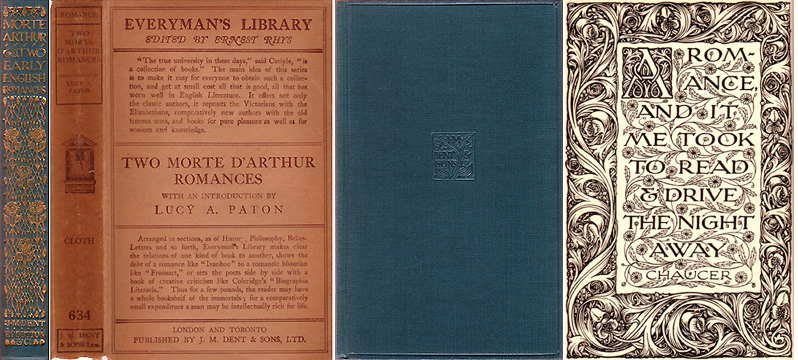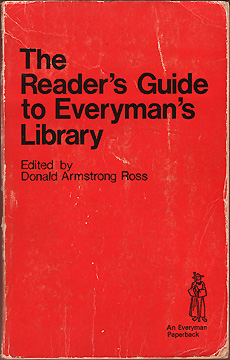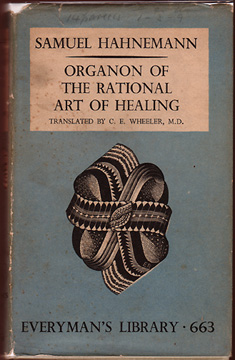A Review of Terry Seymour's A Guide to Collecting Everyman's Library
|
A Review of Terry Seymour's A Guide to Collecting Everyman's Library |
|
Why might Modern Library collectors be interested in Dent & Sons' Everyman's Library? These
two venerable series of "classic" reprints certainly dominated the trade in such
series for much of the 20th century, and are approximately the same size, making
it easy to pick them out while looking for Modern Library books in used
bookstores (Everyman's titles were distributed in large quantities in the U.S.
by Dutton, and are relatively easy to find). Both series fit nicely together on
bookshelves, particularly if you have lowered the height of the shelves to fit
the shorter format of the Modern Library. Both series have a distinctive
aesthetic - the Modern Library dust jackets (at least the pictorial ones) are
more interesting than Everyman's, but the binding and interior of Everyman's,
particularly earlier editions, are more impressive. |

|
|
A more important reason to collect both series is that despite some overlap,
there are many titles unique to each series. Everyman's 1081 different
titles contain many more classic literary works, many with extensive
scholarly introductions, and has numerous titles in biography, history, science,
travel, and oratory. The Modern Library focused on more "modern" literary works
that were largely absent from Everyman's (at least through the late 1930s). In
other words, together the Modern Library and Everyman's Library can comprise a
significant library of classic and modern literary works. There are two books collectors of Everyman's Library must have. The first is 30 years old and long out of print, The Reader's Guide to Everyman's Library, 4th ed. (Donald Armstrong Ross, ed., London: J.M. Dent & Sons, 1976). This 4th edition of the Reader's Guide (first included in Everyman's Library in 1932 as #889) is significantly different from earlier editions in that it includes (or at least tried to include) every title ever published in Everyman's. Earlier editions of the Reader's Guide included only titles currently in print. The Reader's Guide is just that - a guide listing all Everyman's titles with a brief description of the contents, prefaced with a history of the series. Nothing like this exists for the Modern Library. The Reader's Guide is invaluable as a guide to learning quickly about the content of the titles in the series. Unfortunately, the 4th edition of the Reader's Guide was published only as a cheaply bound paperback, printed on poor paper. It is possible to find a copy for $15 to $20 on the internet. |
  |
|
The second book vital to collecting Everyman's Library is Terry Seymour's A
Guide to Collecting Everyman's Library, published in February of 2005
(Author House, $19.95 paperback, $30.25 hardcover, available at authorhouse.com).
Seymour's Guide is an astounding labor of love by a long-time Everyman's
collector who has expended significant time and effort on the book. Seymour
has amassed over 5000 Everyman's Library books in the process. A Guide
to Collecting Everyman's Library complements the Reader's Guide by
including a wealth of information vital to the Everyman's Library
collector (as compared to the reader) that is absent from the Reader's
Guide. Seymour's book contains 70 pages of introductory material outlining the history of Everyman's Library, the evolving design of Everyman's Library books, and dozens of miscellaneous subjects pertinent to understanding the series (dust jackets, pricing, numbering anomalies, scarcity, books relating to the series, etc.). Everyman's titles only published in the U.S.? Editorial errors? Numbering inconsistencies? Everyman's Library catalogs? Half-calf leather bindings? They are all in Seymour's book. The majority of Seymour's Guide consists of bibliographic entries for each title in Everyman's Library. These entries follow the same sequence as the earlier Reader's Guide, but include additional information, including details about the first printing of each Everyman's Library title (equivalent to the First Modern Library edition information in Toledano's Modern Library Price Guide). Serious collectors need this kind of information, particularly if they are seeking first printings of Everyman's titles. Unlike the Modern Library, Everyman's Library did not include a statement of first printing (or edition) in its books until the late 1920s. Also unique to Seymour's Guide is information about sales of each title and a related indicator of scarcity. The sales and scarcity information is worth the price of the book alone. Seymour located a sales ledger in the Dent & Sons archives (currently at the University of North Carolina-Chapel Hill) containing year-by-year sales for each Everyman's title (in the UK and US) for 1906 (when the series began) to 1951. This is stupendous information for Everyman's collectors, as it is clear which titles are easy to find and which ones are difficult - and helps focus the search for tough titles on the internet (with over 1000 titles, it is vital to narrow the search). It is also good to know, when visiting used bookstores, if a title on the shelf is scarce or common. Seymour's Guide is also important for used book dealers. The pricing of Everyman's Library titles on the internet and in book stores is all over the place - common titles listed for hundreds of dollars and scarce copies for under $10. The latter is often the case, as dealers believe the titles to be cheap reprints of minimal value. A Guide to Collecting Everyman's Library should encourage more people to collect Everyman's Library, and, subsequently, dealers will be able to price their scarce copies of Everyman's titles appropriately. In addition, as Everyman's (and Modern) Library dealer Joe Hill will attest, Everyman's titles have a market beyond the collector, as a significant number are still the most readily available scholarly editions of important fiction and non-fiction titles. A Guide to Collecting Everyman's Library along with the Reader's Guide will help dealers accurately price Everyman's titles for both collectors and non-collectors alike. Samuel Hahnemann's Organon of the Rational Art of Healing is a good example of a title the Modern Library would never have included in the series. But how can any respectable home library be without it? I use the Organon to illustrate the different information included in the The Reader's Guide to Everyman's Library, 4th ed. and Seymour's Guide to Collecting Everyman's Library. |

|
|
The Reader's Guide entry (above left) for the Organon includes
the author, book title, and information about introductions and translators,
followed by a brief description of the book content. The final line contains
the year of initial publication and number of pages in the book. The Guide to Collecting Everyman's Library (above right) also contains the author, book title, and information about introductions and translators. If any information in the Reader's Guide is incorrect, it is corrected in Seymour's Guide. 663 refers to the Everyman's Library series number, and 475.0 a entry number assigned by Seymour (where the book falls in alphabetical order in the series). If variants of a title exist (new translations, revisions, etc.) the number to the right of the decimal is used to designate variants. Additional information in Seymour's Guide includes the section of Everyman's Library the title was in (in this case SCI = Science) and the number of introductory pages. Details about the first printing follow: in this case 1913. NS indicates that the first did not include the year of publication. Subsequent printing dates were usually included, however. Beginning in the late 1920s the year of first and subsequent printings was included in most Everyman's titles. 1/1/1/U indicates the state of the first printing: the first number is the style of the book, (there are 5 major styles over the years), the second number is the style of endpaper (there are 6 styles), the third number is the style of the appropriate first printing dust jacket (there are 11 styles), and the final letter indicates if the series number was included in the book itself (U means it was unnumbered). The printer of the first printing of the title is indicated, as is a scarcity value and, in parenthesis, actual sales of the title (through 1951). The Organon title pictured above, despite being a first printing, has a later binding style and dust jacket. Each printing of Everyman's Library was approximately 10,000. The unbound books sat in storage until orders were placed. In the case of perpetually unpopular titles, like the Organon, it is common to find a first printing (in this case, 1913) with a much later binding and dust jacket (this book was probably bound and jacketed in the late 1930s). Thus the importance of Seymour's Guide for identifying first printings and their appropriate binding and jackets. Finally, notes include a diversity of information about the title gleaned from Seymour's long collecting career. A Guide to Collecting Everyman's Library has its flaws: a few formatting errors and minor typos are scattered throughout the book, and the photographs illustrating characteristics of the books are reproduced poorly and stuck in the back of the book. The references to these illustrations are in the front section of the book, so one must flip back and forth between them. This latter flaw seems to be more of a consequence of the book publisher, rather than author. But these few flaws in no way detract from the importance of A Guide to Collecting Everyman's Library. I predict that the Guide will encourage a whole new generation of collectors to seek copies of Everyman's Library titles, attracted by the classic book design, scholarly and well-chosen content of the titles in the series, and the knowledge about the series contained in Terry Seymour's Guide to Collecting Everyman's Library. - John Krygier |